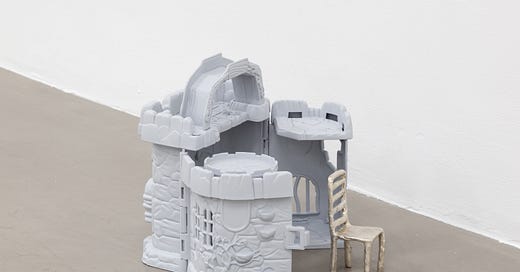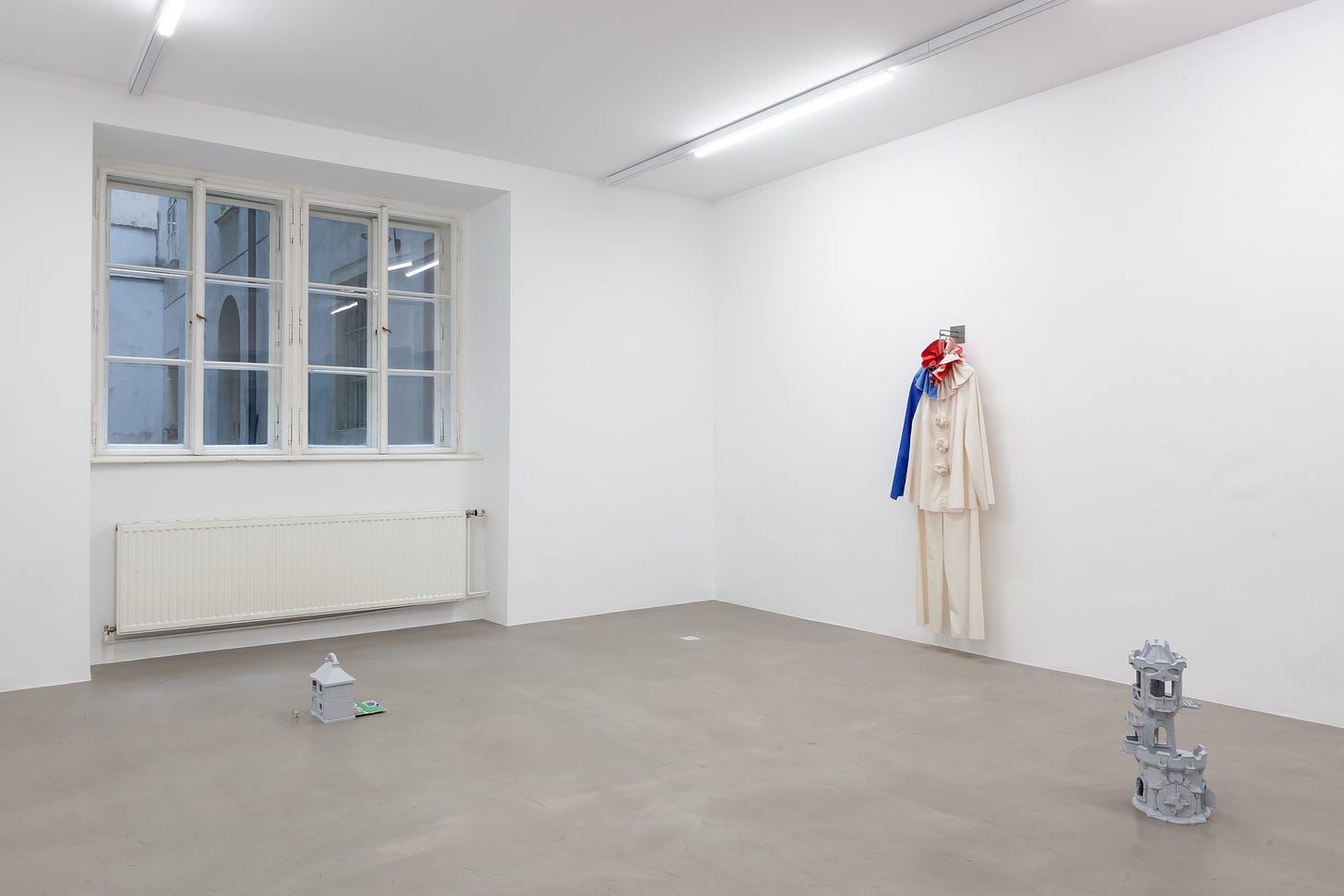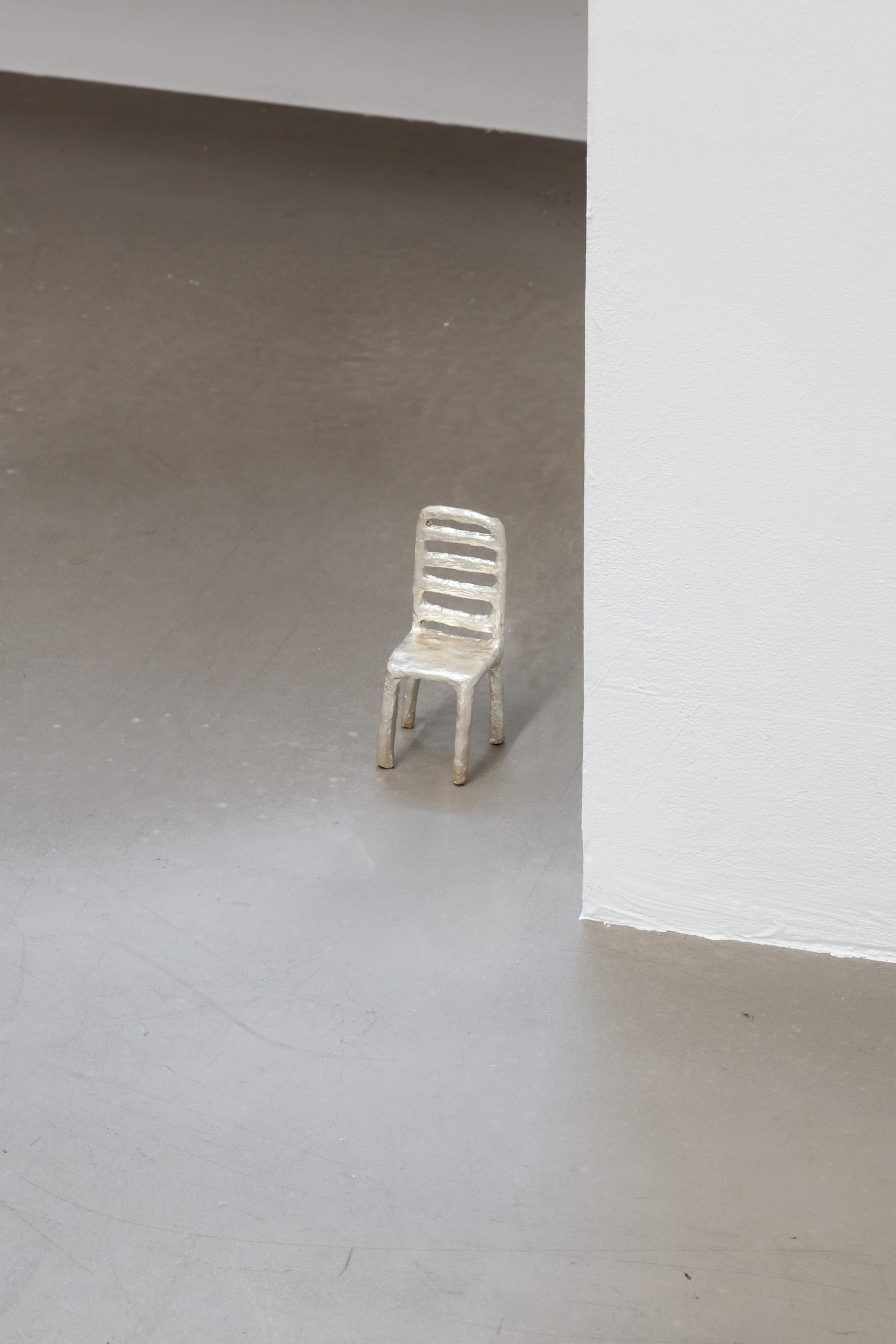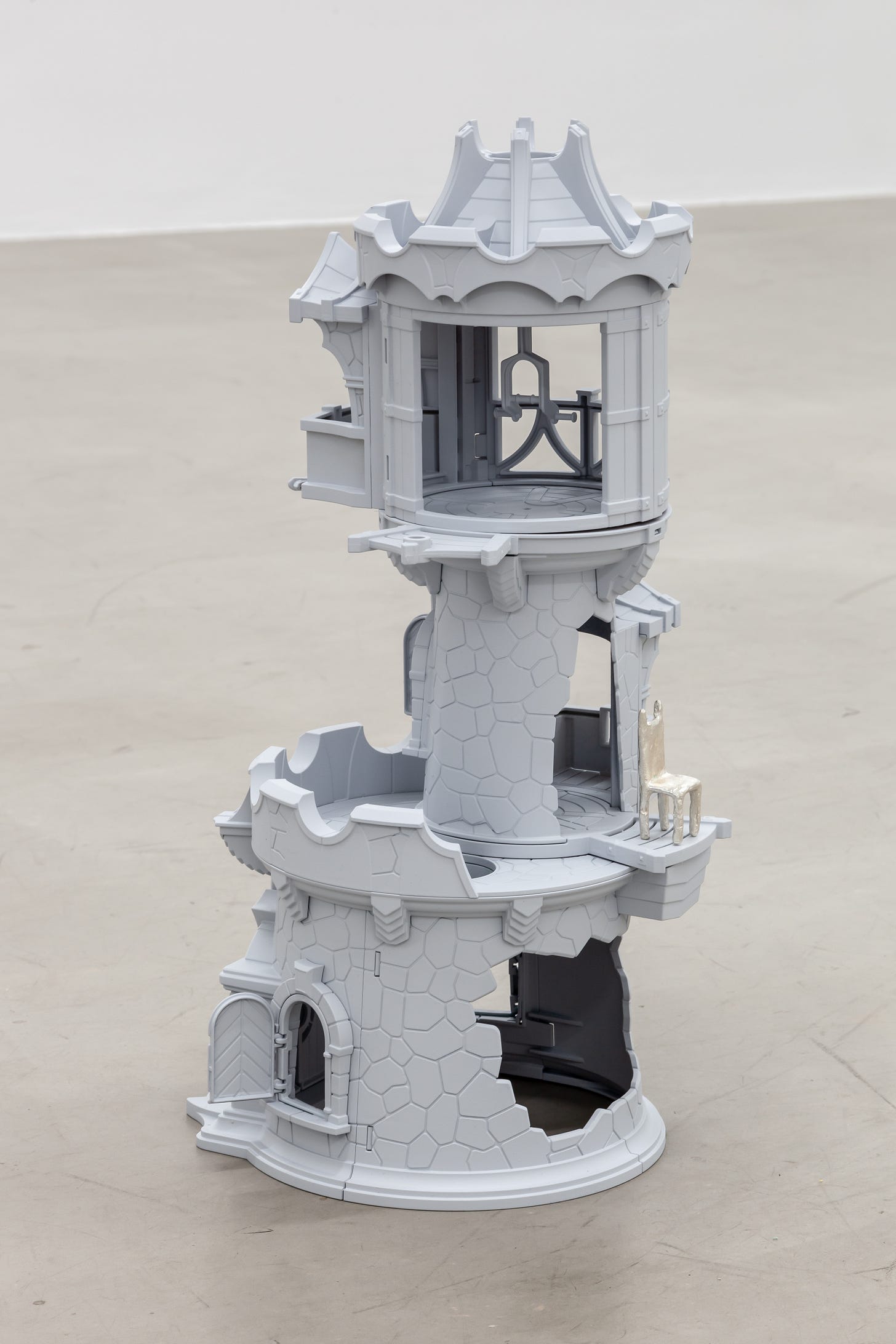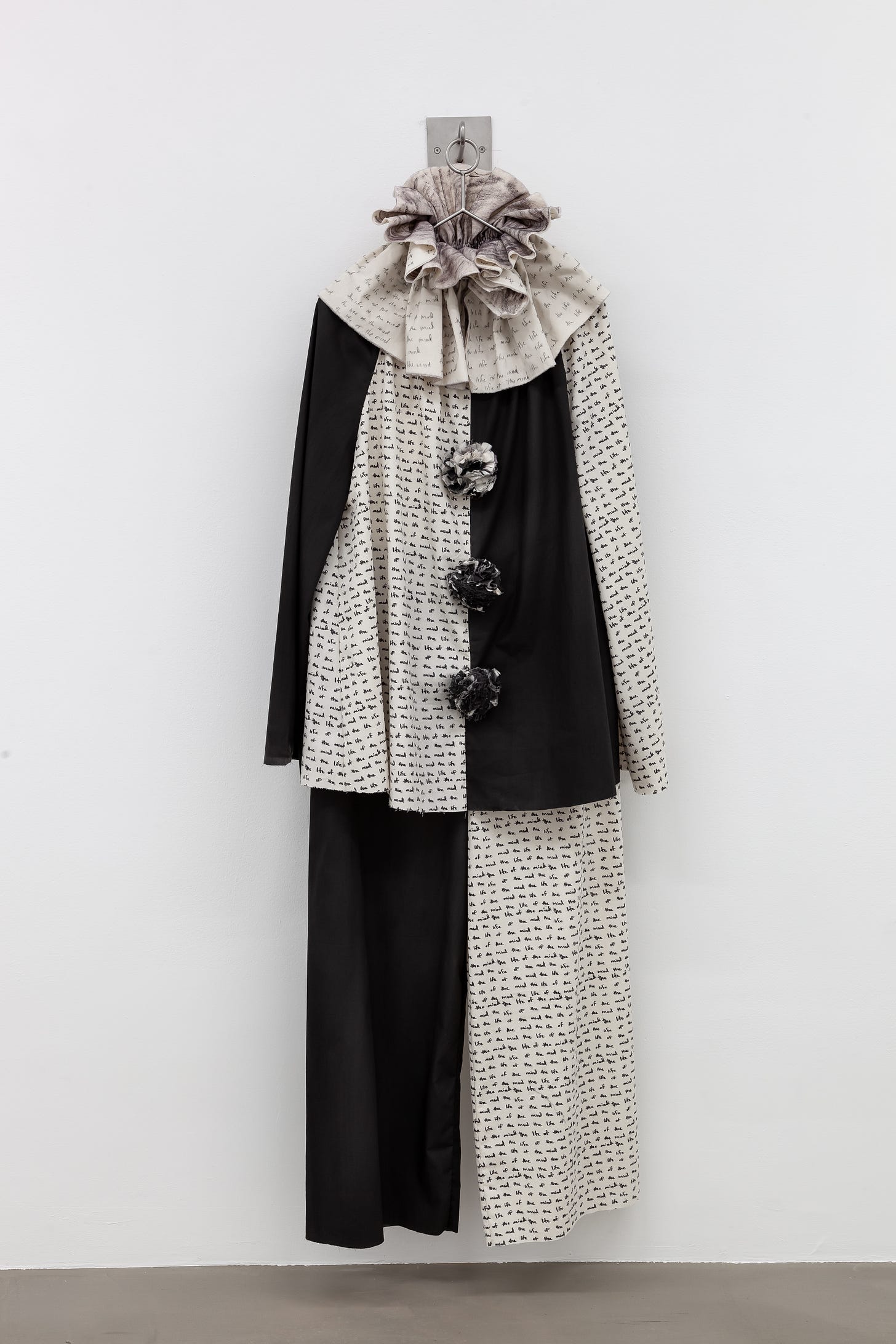Fantasies of 'Stuff': Ellen Schafer's Exhibition at Wonnerth Dejaco
I want a big castle with a pool, to eat on silver sterling chairs, and to wear handmade garments! Does this sound like a kid’s dream or an image on your future vision board? Or perhaps, these are just some stuff ... But stuff is not just stuffy stuff – it always tells a story. Its colour may remind you of your first car, its origin may still haunt your old uncle, or maybe you just look at stuff and picture how amazing it would look next to your bookshelf. Either way, stuff can be anything; behind all stuff, there is no escape from its story. And today, I have another tale about stuff to share.
Once upon a time, the Los Angeles-based artist Ellen Schafer made sterling chair miniatures and decided to bring these on a flight to Vienna. In our city, she was on a mission to find pedestals, stuff, to compliment her self-made chairs. But once she found children’s playhouses at the Carla charity shop, the story she once wrote for her chairs suddenly had changed, which led to her playing with the notion of how we project fantasies onto objects.
Last week, Schafer opened her solo exhibition called (you guessed it) Stuff at the Wonnerth Dejaco Gallery in the centre of Vienna (04/07-24/08/2024). Alongside chair miniatures and self-made garments, Stuff exhibits play toys that are customised by Schafer in a polished way that allows viewers to freely imagine the individual stories behind them.
Long dark hair with a blunt fringe, Ellen Schafer looks like this cool, effortless girl with a welcoming smile that you simply want to talk to. At her opening party, Schafer was talkative and took her time to chat with all visitors. While she was eager to tell her story, she was also very mindful of every word she chose to translate her thoughts. When somebody accidentally bumped into one of the play toys, everybody immediately stared in absolute shock and silence. But Schafer remained extremely calm and warmly smiled it off, ensuring everyone softly that nothing had happened. At that moment, I knew that her laid-back, dreamy character had to be covered in ArtNaVee, hence I made sure to catch Schafer right before she returned to Los Angeles.
Stuff, Ellen Schafer, 2024. Wonnerth Dejaco. 4th of July - 24th of August 2024. Pictures courtesy of Wonnerth Dejaco.
Who are you, and what are you doing in Vienna?
I am an artist that lives in LA, but I’ve been formed as an artist in different places. Initially, I studied Art History in New York. Once I moved to Glasgow, Scotland, to attend art school, I became very focused on making work and developing conversation with myself and others. I studied sculpture in an environmental art programme with a focus on materiality. This shaped my interest in how art finds itself in public spaces and how it can define living relationships to materials.
My relationship to Vienna began with my artist roommate in Glasgow, who was an artist from here. There was a strong, vibrant community surrounding our art school in Glasgow, and he introduced me to other Viennese artists who were on exchange. In a way, the artist community is like a travelling circus – there are many connections that span across large distances. I became connected to Wonnerth Dejaco through connections and dialogues with other artists. This is my second solo exhibition in this gallery; I did my first show in 2021.
My Life As Chair IX, 2024. Silver plated brass. 10 x 4.5 x 4 cm.
I see, Glasgow made you focus more on the materiality of art. What does that mean? Do you define art as something that is physical?
What interests me is the world of material objects that art produces in masses. I relate to this as someone who uses objects, and as someone who’s interested in making my own objects. When I make my objects, I think of the way people see, use, and discard them. What I have taken from Glasgow is the way I analyse the life and sensitivity of a material object.
To me, art is embodied within; I always have a need for touch. It comes from a way of handling things – my hands always have to make and mend something through touch. I have an intense need to handle things that already exist in this world. So, I take things and change them in different ways. By taking them from their original world and adjusting them into something else, you can look at things from different perspectives. Therefore, touch and intervention are always involved in my progress.
Where do you get your inspiration from?
I am drawn to the arrangement of things, but it doesn’t have to be specific. Today, I was walking through the streets of Vienna and came across a store that repairs dolls and stuffed animals. I was intrigued by the shop window – there were many old, old stuffy animals that were haphazardly stacked in a pile on top of each other. It reminded me of an artwork I once made with stuffed animals in a sink apparatus. The artwork was obviously made in another context, yet both settings carry the stacking of stuffed animals, which I found very interesting. The other day, I found an old puzzle piece on the side walk, which I picked up and thought about sewing into a garment. There is this endless formation of things in this world, which each bring a unique visual pleasure to me. For the most part, I’m drawn to pre-existing things that I encounter in the everyday world. I am intrigued by things that excite me for no exact reason. These are the materials that always raise questions to me.
House I, 2024. Toy, paint. 54 x 26 x 26 cm. My Life As Chair IV, 2024. Silver plated brass. 6.5 x 2.5 x 2.5 cm.
What is the story behind your Stuff exhibition?
Before coming to Vienna, I made the sterling chairs. I’m drawn to chairs as universal objects – chairs are objects that range in scales, they’re not necessarily made for one specific idea of body. In a way, I see these chairs as replacements of bodies; they are human bodies as much as objects.
I planned to find objects that could serve as a non-traditional plinth (pedestal; the bottom of a statue) for these chairs. Initially, I looked for some kind of toy. I went to one of the Carlas here and the first thing I found was a multi-tiered castle structure. It had so many levels, entryways, passageways – so much visual information in a single play toy. Immediately, an instinct told me that this is the object I needed for the show! After that, I found more structures that presented a fantasy domestic space, and that’s when my relationship to these objects suddenly shifted to what they could become. I realised that with these very specific ramble toys, I wanted to play with house-like structures. Structures of castles, houses, mansions – these are all different objects that represent a fantasy home in a universal way; it’s a dungeon of a fantastical structure. Some of these objects were intentionally designed for boy players, some were coded as girl toys. I aimed to remove as much of this as possible. By removing some characteristics with paint, you’re able to look at the structures more closely, while still keeping the essential information. I was drawn to these objects as planned structures that emphasise early forms of socialisation (e.g. think of domestic family roles).
Once I place the chairs back into these miniature domestic spaces, they had a different role and context. The domestic environment comes with different accessories for the playhouse, but the chair in this context is not only furniture, it’s also a body. I like that relationship.
What are the garments that are hanging on the walls, did you make them?
These are Pierrot costumes (historic clown costumes) that are painted and sewn by me. I’ve always worked with the idea of the costume as a making of the self – by dressing yourself, you choose a way to present yourself to the world. In this case, the clown has been a trope for artists to tell and reflect a story about the self, and I like the storytelling function behind that. I wanted to play with how the hand can be captured in materiality, which is why I did not hem the sleeves and let the suit have raw edges. Suit V has a digital pattern that I made; it’s a text piece that I had written in graphite, scanned, and then printed this onto the fabric. The collar is my handwriting over and over again. Suit IV is made from scraps of fabric, which were leftovers from printing mistakes and painting edges. I liked to explore the slippages of machines and the hand.
Suit V, 2024. Silk paint, oil pastel, charcoal and digital print on muslin, brushed stainless steel. 178 x 56 x 24 cm.
What keeps bringing you back to Vienna, and what will you do once you’re back home?
It’s mainly the people! I really like the vibrant community of artists in Vienna – people are constantly working on shows together, they are always collaborating. Just being able to open my show alongside the massive group exhibition at Galerie Wonnerth Dejaco has been really wonderful. I enjoy spending so much time in this gallery. Vienna is very different from Los Angeles – there are different conditions, which leads to different visuals and materialities, as well as different ways of thinking. I feel privileged that I can insert myself into another culture. It makes me rethink certain things in my work and important things in my personal life. For now, I am just excited to go back to the studio and to pick up the plans and projects that I left behind!
Would you like to lie on the floor and dream away behind miniature mansions?You can still check out some stuff in Ellen Schafer’s solo exhibition at Wonnerth Dejaco until August 24, 2024. Galerie Wonnerth Dejaco: Ballgasse 6, 1010 Wien.
ARTNAVEE OPEN CALL
Are you on the hunt for a small summer project? Do you have a passion for art and a unique perspective to share? This summer, ArtNaVee invites you to contribute to the art newsletter!
ArtNaVee aims to make art understandable for those who want to learn more about art beyond museum visits. By bringing artists and creatives closer to the viewer, we open the discussion about art to the public in an accessible manner. A big part of this is making YOU part of the debate and circle, which is why ArtNaVee is looking for guest articles!
This is a fun opportunity to showcase your writing, share your insights, and become part of the ArtNaVee community of art enthusiasts. Whether you are an artist, critic, or art lover, we would love to hear from you!
What we’re looking for:
Creative perspectives: Share your artistic progress and inspiration; an artist diary. Tell a personal story about what inspires you to make art.
Engaging stories: Write about a memorable art event or how you found your love for art. What exhibition do you still think of today?
Insightful articles: What art debates keep you busy? Share what you think about when you look at art. What is the art scene like in your city or country? Who is your favourite local artist?
Keep in mind that the article must be written in English and in an accessible (easy to understand) manner. Feel free to include pictures and animations in your submission.
Why contribute?
Build your portfolio: Enhance your writing portfolio with a published piece on ArtNaVee.
Gain exposure: Your article will be featured in this newsletter, reaching a dedicated audience of art enthusiasts. Include a short bio with your links to your portfolio or social media profiles.
Try something new: Share your unique voice and engage with like-minded individuals. Your contribution can help shape the debates around art.
Who can apply?
Anyone who loves art and who enjoys writing. We welcome submissions from writers of all backgrounds and experience levels. You do not have to be an artist or art writer to apply, you just have to be willing to share a fun story.
How to apply?
Subscribe to the ArtNaVee newsletter with your submission email.
Article length: 750-1200 words.
Format: Please submit your article in a PDF document.
Bio: Include a brief biography (50-200 words), including any relevant links.
Email: Send your submission to contact@artnavee.com with the subject line “Guest Article Submission [Your Name]”.
Deadline: Please submit your article by July 25, 2024.
Please note that all selected articles will be reviewed and edited for clarity and consistency. The selected articles will be posted in August 2024.
For any questions or further information, feel free to send an email to contact@artnavee.com. To share this open call with a friend, follow this link.
I look forward to your creative contributions!
Much love,
Nabila from ArtNaVee

